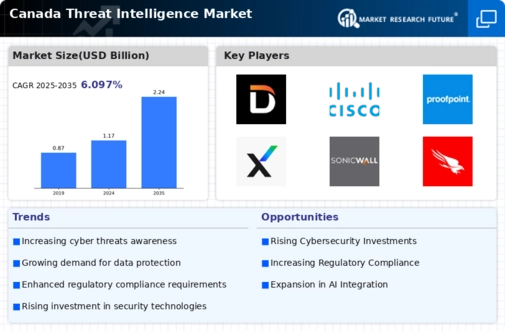The threat intelligence market in Canada is characterized by a dynamic competitive landscape, driven by increasing cyber threats and the growing need for advanced security solutions. Major players such as CrowdStrike (US), FireEye (US), and Palo Alto Networks (US) are at the forefront, each adopting distinct strategies to enhance their market presence. CrowdStrike (US) emphasizes innovation through its cloud-native platform, focusing on AI-driven threat detection and response capabilities. FireEye (US), on the other hand, has positioned itself as a leader in incident response and threat intelligence services, leveraging its extensive experience in cyber threat analysis. Meanwhile, Palo Alto Networks (US) is concentrating on expanding its portfolio through strategic acquisitions and partnerships, aiming to provide comprehensive security solutions that integrate threat intelligence with broader cybersecurity frameworks.
The business tactics employed by these companies reflect a concerted effort to optimize operations and enhance service delivery. The market appears moderately fragmented, with a mix of established players and emerging startups. This structure allows for a diverse range of offerings, although the influence of key players remains substantial. Localizing services and optimizing supply chains are common tactics, enabling companies to respond swiftly to regional threats and customer needs.
In September 2025, CrowdStrike (US) announced a strategic partnership with a leading Canadian telecommunications provider to enhance threat intelligence sharing capabilities. This collaboration is expected to bolster the cybersecurity posture of both organizations, allowing for real-time threat detection and response. Such partnerships are crucial in a landscape where timely information sharing can significantly mitigate risks associated with cyber threats.
In October 2025, FireEye (US) launched a new threat intelligence platform specifically tailored for the Canadian market, integrating local threat data with global insights. This move is indicative of FireEye's commitment to addressing the unique challenges faced by Canadian enterprises, thereby enhancing its competitive edge. By localizing its offerings, FireEye aims to build stronger relationships with clients and improve its service relevance in the region.
In August 2025, Palo Alto Networks (US) completed the acquisition of a Canadian cybersecurity startup specializing in machine learning-based threat detection. This acquisition not only expands Palo Alto's technological capabilities but also signifies a strategic shift towards integrating advanced AI solutions into its threat intelligence offerings. The incorporation of such technologies is likely to enhance the effectiveness of threat detection and response, positioning Palo Alto as a more formidable competitor in the market.
As of November 2025, the competitive trends in the threat intelligence market are increasingly defined by digitalization, AI integration, and a focus on sustainability. Strategic alliances are becoming more prevalent, as companies recognize the value of collaboration in enhancing their service offerings. The shift from price-based competition to a focus on innovation and technology is evident, with firms striving to differentiate themselves through advanced solutions and reliable supply chains. Looking ahead, it seems that competitive differentiation will increasingly hinge on the ability to leverage cutting-edge technologies and foster strategic partnerships, ultimately shaping the future landscape of the threat intelligence market.

























Leave a Comment